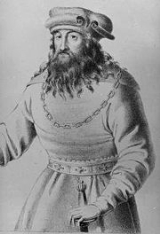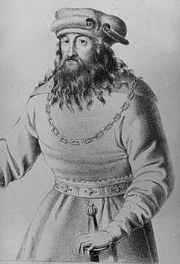
Albert IV, Duke of Austria
Encyclopedia

Duke
A duke or duchess is a member of the nobility, historically of highest rank below the monarch, and historically controlling a duchy...
of Austria.
He was born in Vienna
Vienna
Vienna is the capital and largest city of the Republic of Austria and one of the nine states of Austria. Vienna is Austria's primary city, with a population of about 1.723 million , and is by far the largest city in Austria, as well as its cultural, economic, and political centre...
, the son of Duke Albert III of Austria and Beatrix of Nuremberg. He was the Duke of Austria from 1395 until 1404, which then included roughly today's Lower Austria and most of Upper Austria
Upper Austria
Upper Austria is one of the nine states or Bundesländer of Austria. Its capital is Linz. Upper Austria borders on Germany and the Czech Republic, as well as on the other Austrian states of Lower Austria, Styria, and Salzburg...
, as the other Habsburg
Habsburg
The House of Habsburg , also found as Hapsburg, and also known as House of Austria is one of the most important royal houses of Europe and is best known for being an origin of all of the formally elected Holy Roman Emperors between 1438 and 1740, as well as rulers of the Austrian Empire and...
dominions were at that time ruled by his relatives of the Leopoldinian Line of the family. Albert's rule was characterized by quarrels with that part of his family and with members of the Luxemburg dynasty, Wenceslaus and Sigismund.
Albert died at Klosterneuburg
Klosterneuburg
Klosterneuburg is an attractive small town in Lower Austria, Austria with a population of 24,442.It is located on the Danube, immediately north of Vienna, from which it is separated by the Kahlenberg and Leopoldsberg hills...
, Lower Austria
Lower Austria
Lower Austria is the northeasternmost state of the nine states in Austria. The capital of Lower Austria since 1986 is Sankt Pölten, the most recently designated capital town in Austria. The capital of Lower Austria had formerly been Vienna, even though Vienna is not officially part of Lower Austria...
, in 1404. He is buried in the Ducal Crypt in the Stephansdom
Stephansdom
St. Stephen's Cathedral is the mother church of the Archdiocese of Vienna and the seat of the Archbishop of Vienna, Christoph Cardinal Schönborn, OP...
in Vienna
Vienna
Vienna is the capital and largest city of the Republic of Austria and one of the nine states of Austria. Vienna is Austria's primary city, with a population of about 1.723 million , and is by far the largest city in Austria, as well as its cultural, economic, and political centre...
. He was succeeded by his son Albert
Albert II of Germany
Albert the Magnanimous KG was King of Hungary from 1438 until his death. He was also King of Bohemia, elected King of Germany as Albert II, duke of Luxembourg and, as Albert V, archduke of Austria from 1404.-Biography:Albert was born in Vienna as the son of Albert IV, Duke of Austria, and Johanna...
. Through his maternal grandmother, Elisabeth of Meissen
Elisabeth of Meissen
Elisabeth of Meissen, Burgravine of Nuremberg was the daughter of Frederick II, Margrave of Meissen and Mathilde of Bavaria and a member of the House of Wettin.-Marriage and children:...
, Albert IV descended from Babenberg
Babenberg
Originally from Bamberg in Franconia, now northern Bavaria, an apparent branch of the Babenbergs or Babenberger went on to rule Austria as counts of the march and dukes from 976–1248, before the rise of the house of Habsburg.-One or two families:...
dukes of Austria.
Family and children
He was married in Vienna 24 April 1390 to Johanna Sophia of BavariaJohanna Sophia of Bavaria
Joanna Sophia of Bavaria was the youngest daughter of Albert I, Duke of Bavaria and his first wife Margaret of Brieg. She was a member of the House of Wittelsbach....
, daughter of Albrecht I, Duke of Bavaria-Straubing
Bavaria-Straubing
Bavaria-Straubing denotes the widely-scattered territorial inheritance in the Wittelsbach house of Bavaria that were governed by independent dukes of Bavaria-Straubing between 1353 and 1432; a map of these marches and outliers of the Holy Roman Empire, vividly demonstrates the fractionalisation of...
and Margarete of Brieg. Their children were:
- Margarete (26 June 1395, Vienna–24 December 1447), married in LandshutLandshutLandshut is a city in Bavaria in the south-east of Germany, belonging to both Eastern and Southern Bavaria. Situated on the banks of the River Isar, Landshut is the capital of Lower Bavaria, one of the seven administrative regions of the Free State of Bavaria. It is also the seat of the...
25 November 1412 to Duke Henry XVI of BavariaHenry XVI of BavariaHenry XVI of Bavaria , , since 1393 Duke of Bavaria-Landshut. He was a son of duke Frederick and his wife Maddalena Visconti, a daughter of Bernabò Visconti.-Life:...
. - Albert VAlbert II of GermanyAlbert the Magnanimous KG was King of Hungary from 1438 until his death. He was also King of Bohemia, elected King of Germany as Albert II, duke of Luxembourg and, as Albert V, archduke of Austria from 1404.-Biography:Albert was born in Vienna as the son of Albert IV, Duke of Austria, and Johanna...
(16 August 1397–27 October 1439, Neszmély, Hungary).

